Practical Tips for Dietary Shifts
Shifting to a healthier eating pattern is often easier said than done. Today I want to turn to the brand-new Dietary Guidelines PowerPoint in order to offer some practical tips for dietary shifts.I'm super excited to share this free preview with you -- if you like what you see, you can learn more about the full PowerPoint today!Remember, making dietary shifts is all about good health. The Dietary Guidelines for Americans recommend that people “Shift to healthier food and beverage choices. Choose nutrient-dense foods and beverages across and within all food groups in place of less healthy choices. Consider cultural and personal preferences to make these shifts easier to accomplish and maintain.”Let's take a look at a few sample shifts, shall we?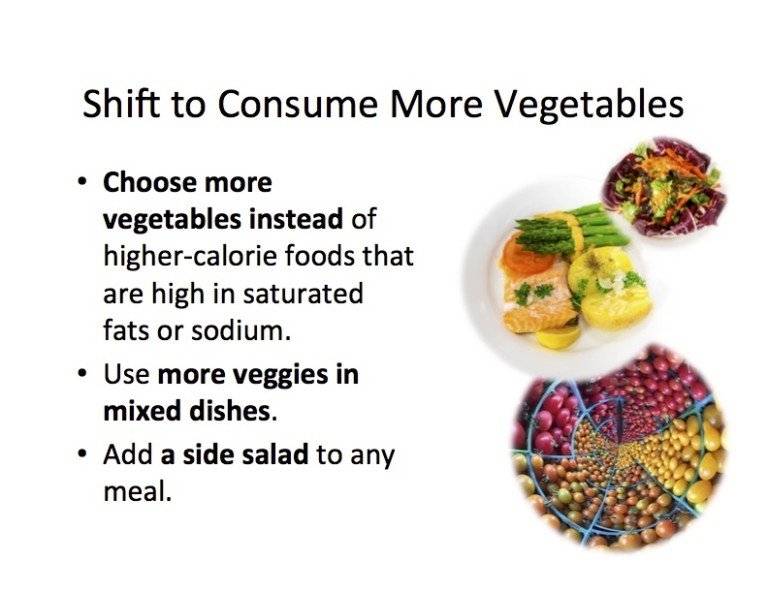 Most people need to eat more fruits and vegetables. It would be wise to increase your total vegetable intake from all the vegetable subgroups — dark green, red and orange, legumes, starchy, and other. The guidelines assert “Strategies to increase vegetable intake include choosing more vegetables — from all subgroups — in place of foods high in calories, saturated fats, or sodium such as some meats, poultry, cheeses, and snack foods.” You can also try to include veggies in mixed dishes like chilis or casseroles while decreasing saturated-fat-rich meats or refined grains. And finally, you could add a green salad or veggie side to every meal.
Most people need to eat more fruits and vegetables. It would be wise to increase your total vegetable intake from all the vegetable subgroups — dark green, red and orange, legumes, starchy, and other. The guidelines assert “Strategies to increase vegetable intake include choosing more vegetables — from all subgroups — in place of foods high in calories, saturated fats, or sodium such as some meats, poultry, cheeses, and snack foods.” You can also try to include veggies in mixed dishes like chilis or casseroles while decreasing saturated-fat-rich meats or refined grains. And finally, you could add a green salad or veggie side to every meal.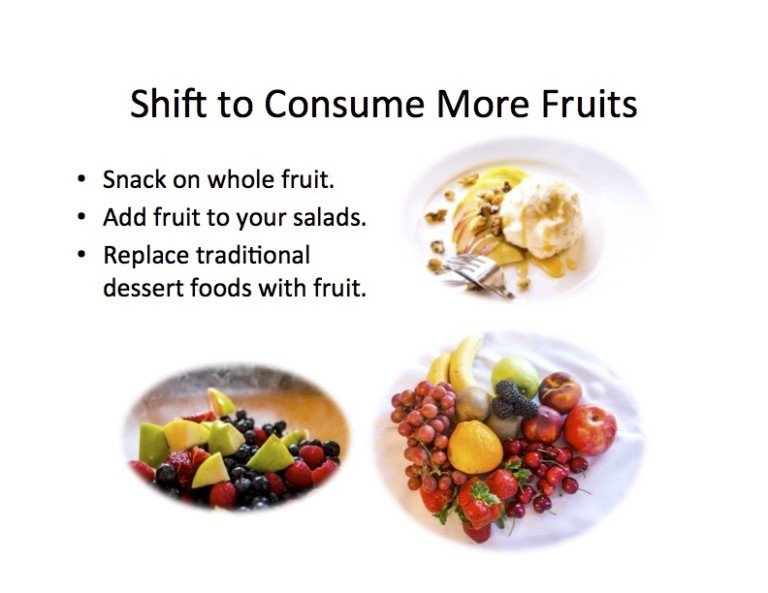 According to the Dietary Guidelines for Americans, “To help support healthy eating patterns, most individuals in the United States would benefit from increasing their intake of fruits, mostly whole fruits, in nutrient-dense forms.” Try snacking on more fruit or tossing some fruit into your next salad. Fruits also make great desserts – use them to replace foods that are high in added sugars, saturated fat, and refined grains.And for our final sample shift, let's explore grains.
According to the Dietary Guidelines for Americans, “To help support healthy eating patterns, most individuals in the United States would benefit from increasing their intake of fruits, mostly whole fruits, in nutrient-dense forms.” Try snacking on more fruit or tossing some fruit into your next salad. Fruits also make great desserts – use them to replace foods that are high in added sugars, saturated fat, and refined grains.And for our final sample shift, let's explore grains.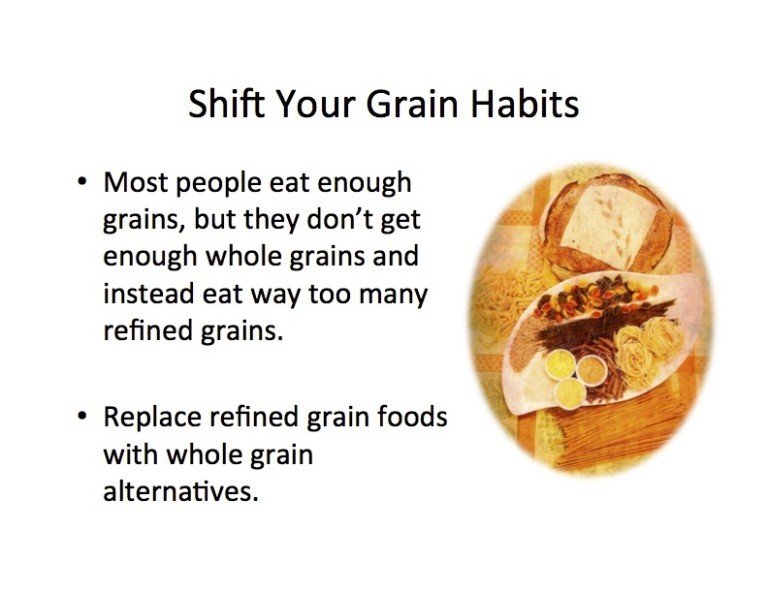 Most people eat enough grains, but they don’t get enough whole grains and instead eat way too many refined grains. Replace refined grain foods with whole grain alternatives. There are lots of ways to do this. For example, you could use the ingredient list on packaged grain foods to make sure that the first ingredient is a whole grain, rather than a refined grain. General replacements are a great idea. The guidelines take this a step further, insisting, “Choosing both whole and refined grain foods in nutrient-dense forms, such as choosing plain popcorn instead of buttered, bread instead of croissants, and English muffins instead of biscuits also can help in meeting recommendations for a healthy eating pattern.”There are lots of other eating pattern shifts explored in this presentation, but that's where I'm going to stop the preview for today. If you liked what you saw, get those 3 slides for free! Or get the whole PowerPoint and handout set -- it's one of the best nutrition education materials that my team and I have ever created.
Most people eat enough grains, but they don’t get enough whole grains and instead eat way too many refined grains. Replace refined grain foods with whole grain alternatives. There are lots of ways to do this. For example, you could use the ingredient list on packaged grain foods to make sure that the first ingredient is a whole grain, rather than a refined grain. General replacements are a great idea. The guidelines take this a step further, insisting, “Choosing both whole and refined grain foods in nutrient-dense forms, such as choosing plain popcorn instead of buttered, bread instead of croissants, and English muffins instead of biscuits also can help in meeting recommendations for a healthy eating pattern.”There are lots of other eating pattern shifts explored in this presentation, but that's where I'm going to stop the preview for today. If you liked what you saw, get those 3 slides for free! Or get the whole PowerPoint and handout set -- it's one of the best nutrition education materials that my team and I have ever created.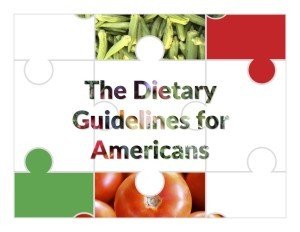 Oh, and if you're a member, then today is your lucky day! So far we've discussed a few examples of foods and food elements to shift towards, and in the member-exclusive post Shift Away from Added Sugars and Saturated Fats, we're going to explore a few food elements to shift from. It's a fantastic post -- you won't want to miss it! And it comes with even more PDF slides from that PowerPoint presentation!
Oh, and if you're a member, then today is your lucky day! So far we've discussed a few examples of foods and food elements to shift towards, and in the member-exclusive post Shift Away from Added Sugars and Saturated Fats, we're going to explore a few food elements to shift from. It's a fantastic post -- you won't want to miss it! And it comes with even more PDF slides from that PowerPoint presentation!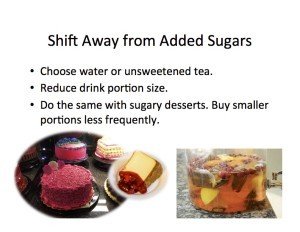 And, as always, we're here to help you look your very best, right now! Don't miss these brand-new educational resources for the 2015-2020 Dietary Guidelines for Americans. All this -- and more! -- is in the Nutrition Education Store!
And, as always, we're here to help you look your very best, right now! Don't miss these brand-new educational resources for the 2015-2020 Dietary Guidelines for Americans. All this -- and more! -- is in the Nutrition Education Store!



